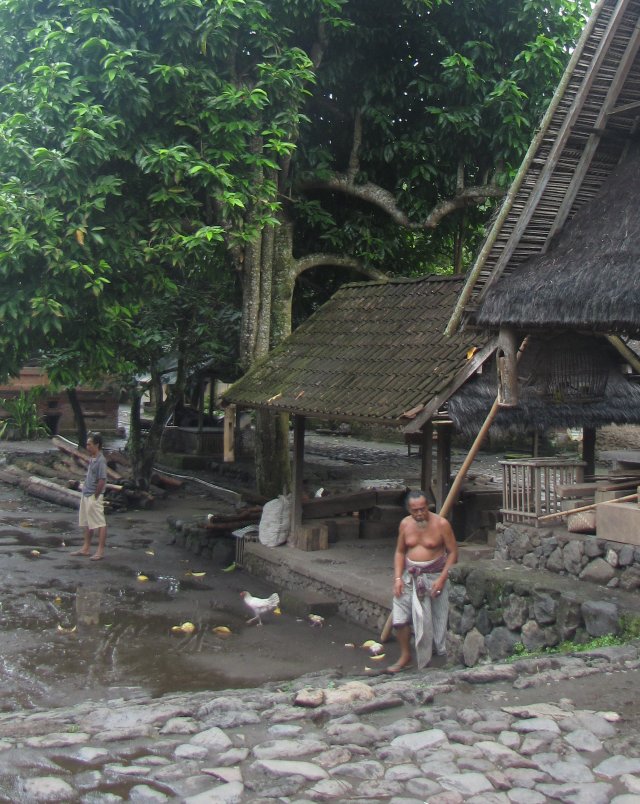|
Trunyan
Trunyan or Terunyan is a Balinese village (''banjar'') located on the eastern shore of Lake Batur, a caldera lake in Bangli Regency, central Bali, Indonesia. The village is one of the most notable homes of the Bali Aga people, the others being the villages of Tenganan and Sambiran. Trunyan is notable for its peculiar treatment of dead bodies, in which they are placed openly on the ground, simply covered with cloth and bamboo canopies, and left to decompose. The influence of a nearby tree is said to remove the putrid smell of the corpses. Description Trunyan is one of the culturally isolated Bali Aga villages in Bali. Trunyan village is located on the isolated eastern shore of the crescent-shaped Lake Batur, at the foot of Mount Abang, a peak on the eastern rim of the large caldera. The village is most easily accessible by boat. The people of Trunyan are generally considered to be Bali Aga people, the mountain Balinese. Unlike the lowland Balinese, Bali Aga people practice ... [...More Info...] [...Related Items...] OR: [Wikipedia] [Google] [Baidu] |
Trunyan 200507
Trunyan or Terunyan is a Balinese village (''banjar'') located on the eastern shore of Lake Batur, a caldera lake in Bangli Regency, central Bali, Indonesia. The village is one of the most notable homes of the Bali Aga people, the others being the villages of Tenganan and Sambiran. Trunyan is notable for its peculiar treatment of dead bodies, in which they are placed openly on the ground, simply covered with cloth and bamboo canopies, and left to decompose. The influence of a nearby tree is said to remove the putrid smell of the corpses. Description Trunyan is one of the culturally isolated Bali Aga villages in Bali. Trunyan village is located on the isolated eastern shore of the crescent-shaped Lake Batur, at the foot of Mount Abang, a peak on the eastern rim of the large caldera. The village is most easily accessible by boat. The people of Trunyan are generally considered to be Bali Aga people, the mountain Balinese. Unlike the lowland Balinese, Bali Aga people practice ancien ... [...More Info...] [...Related Items...] OR: [Wikipedia] [Google] [Baidu] |
Bali Aga
The Bali Aga, Baliaga, or Bali Mula are the indigenous people of Bali. Linguistically they are an Austronesian people. Bali Aga people are predominantly located in the eastern part of the island, in Bangli Regency, Bangli especially the mountains Kintamani, Bangli, Kintamani, Buleleng Regency, East Buleleng, Buleleng, West Buleleng and Karangasem Regency, East Karangasem, but they can also be found in north-western and central regions. The term ''Bali Aga'' or ''Bali Pégunungan'' (Mountain Balinese) is regarded as an insult with an additional meaning of "the mountain people that are fools"; therefore, they prefer the term ''Bali Mula'' (''lit''. Original Balinese) instead. Bali Aga people who are referred to as ''Bali Pégunungan'' (Mountain Balinese) are those that are located at Trunyan village. For the Trunyan Bali Aga people, the term ''Bali Aga'' or ''Bali Pégunungan'' (Balinese: Mountain Balinese) is regarded as an insult with an additional meaning of "the mountain peop ... [...More Info...] [...Related Items...] OR: [Wikipedia] [Google] [Baidu] |
Bangli Regency
Bangli Regency (; ) is the one and only landlocked Regency (Indonesia), regency (''kabupaten'') of the province of Bali, Indonesia. It covers a land area of 520.80 km2, and had a population of 259,392 in 2024. It is bordered by Badung Regency to its west, Gianyar Regency to its west and south, Buleleng Regency to its west and north, Karangasem Regency to its east and Klungkung Regency to its south. The administrative centre is at the town of Bangli. Up until 1907, Bangli was one of the nine kingdoms of Bali. The capital has a famous Hindu temple, the Pura Kehen, Kehen Temple, which dates from the 11th century. Bangli also has one village which surrounds a hill, Demulih. Pura Dalem Galiran is 1.4 km north-west of Bangli. Pura Dalem Penunggekan, 1.3 km south of the town center, Etymology Legend According to the Kehen Temple Inscription stored in the Kehen Temple, it is said that in the 11th century in Bangli Village, an epidemic called ''kegeringan'' developed ... [...More Info...] [...Related Items...] OR: [Wikipedia] [Google] [Baidu] |
Mount Batur
Mount Batur ''(Gunung Batur)'' is an active volcano located at the center of two concentric calderas northwest of Mount Agung on the island of Bali, Indonesia. The southeast side of the larger 10×13 km caldera contains a caldera lake. Both the larger caldera, and a smaller 7.5 km caldera were formed by a collapse of the magma chamber, the first larger collapse taking place about 29,300 years ago, and the second inner caldera collapsing about 20,150 years ago. Another estimate of the inner caldera's formation date, formed during the emplacement of the Bali (or Ubud) ignimbrite, has been dated at about 23,670 and 28,500 years ago. The first documented eruption was in 1804 and the most recent was in 2000. Active volcano and Lake Batur in the caldera The eruption that brought this volcano to be visible above the ocean is one of the most forceful on the Earth. This volcano is marked by a collapsed top, called a caldera. The caldera contains an active, 700-metre-tall st ... [...More Info...] [...Related Items...] OR: [Wikipedia] [Google] [Baidu] |
Balinese Copperplate Inscription
The Balinese copperplate inscription or Sembiran inscription is a collection of ten copper plate inscriptions, which were found in the village of Sembiran, Tejakula district, Buleleng Regency, on the northern part of Bali island. All inscription plates have a date, which is between 922 and 1181 CE, so they include more than 200 years. Sembiran AI is dated 844 saka (922 CE), Sembiran B is dated 873 saka (951 CE), Sembiran A II is dated 897 saka (975 CE), Sembiran A III is dated 938 saka (1016 CE), Sembiran A IV is dated 987 saka (1065 CE), and Sembiran C is dated 1103 saka (1181 CE). Some of the oldest inscriptions are written in Old Balinese, while some of the later ones are written in Old Javanese. These inscriptions are the earliest information regarding the condition of the Julah area and its surroundings. The written text states that the inscriptions were addressed to the "''keraman'' of Julah" (Julah village elders). This implies that the original inhabitants of Sembiran vil ... [...More Info...] [...Related Items...] OR: [Wikipedia] [Google] [Baidu] |
Neolithic
The Neolithic or New Stone Age (from Ancient Greek, Greek 'new' and 'stone') is an archaeological period, the final division of the Stone Age in Mesopotamia, Asia, Europe and Africa (c. 10,000 BCE to c. 2,000 BCE). It saw the Neolithic Revolution, a wide-ranging set of developments that appear to have arisen independently in several parts of the world. This "Neolithic package" included the History of agriculture, introduction of farming, domestication of animals, and change from a hunter-gatherer lifestyle to one of sedentism, settlement. The term 'Neolithic' was coined by John Lubbock, 1st Baron Avebury, Sir John Lubbock in 1865 as a refinement of the three-age system. The Neolithic began about 12,000 years ago, when farming appeared in the Epipalaeolithic Near East and Mesopotamia, and later in other parts of the world. It lasted in the Near East until the transitional period of the Chalcolithic (Copper Age) from about 6,500 years ago (4500 BCE), marked by the development ... [...More Info...] [...Related Items...] OR: [Wikipedia] [Google] [Baidu] |
Death Customs
Death is dealt with differently in cultures around the world, and there are ethical issues relating to death, such as martyrdom, suicide and euthanasia. Death refers to the permanent termination of life-sustaining processes in an organism, i.e. when all biological systems of a human being cease to operate. Death and its spiritual ramifications are debated in every manner all over the world. Most civilizations dispose of their dead with rituals developed through spiritual traditions. Disposal of remains In most cultures, after the last offices have been performed and before the onset of significant decay, relations or friends arrange for ritual disposition of the body, either by destruction, or by preservation, or in a secondary use. In the US, this frequently means either cremation or interment in a tomb. There are various methods of destroying human remains, depending on religious or spiritual beliefs, and upon practical necessity. Cremation is a very old and quite common cus ... [...More Info...] [...Related Items...] OR: [Wikipedia] [Google] [Baidu] |
Tourist Attractions In Bali
Tourism is travel for pleasure, and the Commerce, commercial activity of providing and supporting such travel. World Tourism Organization, UN Tourism defines tourism more generally, in terms which go "beyond the common perception of tourism as being limited to holiday activity only", as people "travelling to and staying in places outside their usual environment for not more than one consecutive year for leisure and not less than 24 hours, business and other purposes". Tourism can be Domestic tourism, domestic (within the traveller's own country) or International tourism, international. International tourism has both incoming and outgoing implications on a country's balance of payments. Between the second half of 2008 and the end of 2009, tourism numbers declined due to a severe Economy, economic slowdown (see Great Recession) and the outbreak of the 2009 2009 flu pandemic, H1N1 influenza virus. These numbers, however, recovered until the COVID-19 pandemic put an abrupt end to th ... [...More Info...] [...Related Items...] OR: [Wikipedia] [Google] [Baidu] |
Populated Places In Bali
Population is a set of humans or other organisms in a given region or area. Governments conduct a census to quantify the resident population size within a given jurisdiction. The term is also applied to non-human animals, microorganisms, and plants, and has specific uses within such fields as ecology and genetics. Etymology The word ''population'' is derived from the Late Latin ''populatio'' (a people, a multitude), which itself is derived from the Latin word ''populus'' (a people). Use of the term Social sciences In sociology and population geography, population refers to a group of human beings with some predefined feature in common, such as location, race, ethnicity, nationality, or religion. Ecology In ecology, a population is a group of organisms of the same species which inhabit the same geographical area and are capable of interbreeding. The area of a sexual population is the area where interbreeding is possible between any opposite-sex pair within the are ... [...More Info...] [...Related Items...] OR: [Wikipedia] [Google] [Baidu] |
Balinese Saka Calendar
The Balinese saka calendar is one of two calendars used on the Indonesian island of Bali. Unlike the 210-day pawukon calendar, it is based on the phases of the Moon, and is approximately the same length as the tropical year (solar year, Gregorian year). Months Based on a lunar calendar, the Saka year comprises 12 months, or ''sasih'', each consisting of 30 days. However, because the lunar cycle is slightly shorter than 30 days, and because the lunar year has a length of 354 or 355 days, the calendar is adjusted to prevent it losing synchronization with the lunar or solar cycles. The months are adjusted by allocating two lunar days to one solar day every 9 weeks. This solar day is called ''ngunalatri'', Sanskrit for "minus one night". To stop the Saka year from deviating unduly from the solar year as happens with the Islamic calendar an extra month, known as an intercalary month, is added after the 11th month (when it is known as ''Mala Jiyestha''), or after the 12th month (''Ma ... [...More Info...] [...Related Items...] OR: [Wikipedia] [Google] [Baidu] |








